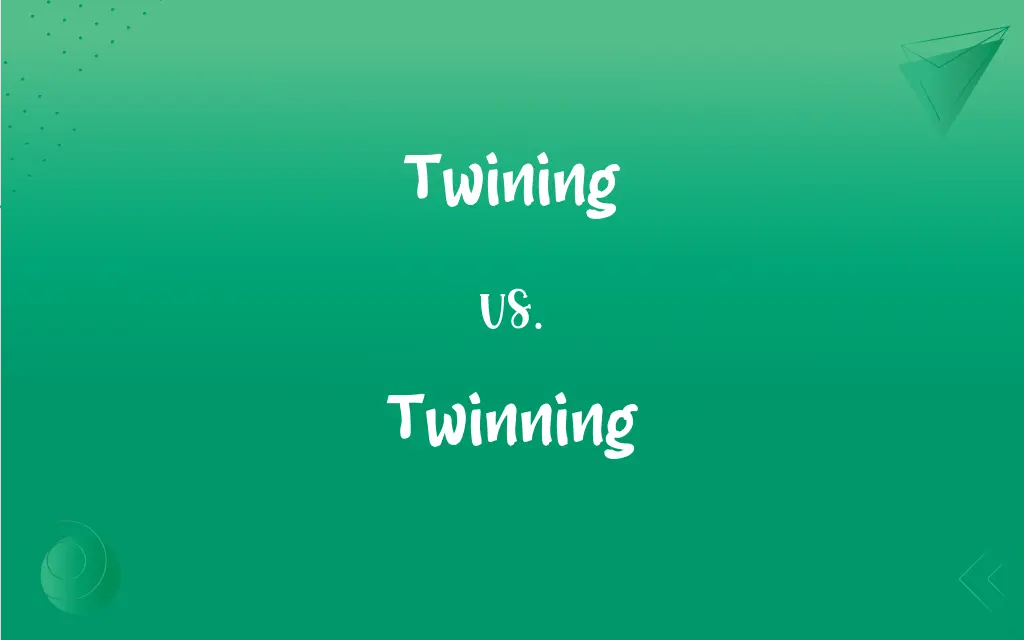Twining vs. Twinning: What's the Difference?
By Janet White || Updated on March 3, 2024
Twining refers to the act of intertwining or coiling around, often used in botany for plants that wrap around supports. Twinning involves the pairing or coupling of two items or individuals, commonly used to describe identical or fraternal twins.

Key Differences
Twining is a term often used in the context of botany to describe the growth habit of certain plants. These plants, known as twiners, have stems or vines that wrap around other plants, structures, or supports as they grow. Twinning, on the other hand, refers to the phenomenon where two offspring are produced in the same pregnancy. Twins can be identical (monozygotic), meaning they come from one fertilized egg that splits and develops into two embryos, or fraternal (dizygotic), meaning they come from two separate eggs fertilized by two separate sperm.
The process of twining in plants is a survival strategy that enables climbing plants to secure themselves for vertical growth without having to invest energy into developing strong, rigid stems. This allows them to compete effectively for light in dense vegetation by using other structures for support. Some common examples of twining plants include morning glories and honeysuckles.
In the context of human biology, twinning is a subject of genetic, developmental, and psychological interest. Identical twins are particularly valuable in scientific studies due to their genetic similarity, which allows researchers to explore the influence of environment versus genetics on various traits and conditions. Twinning can also occur in animals, and in some species, it is more common than in humans.
Cultural and societal attitudes towards twins vary greatly around the world, with twins sometimes being the subject of fascination, celebration, or, in some historical contexts, superstition. Advances in reproductive technology, such as in vitro fertilization, have also impacted the frequency and understanding of twinning in recent years.
Twining and twinning might sound similar, they describe completely different processes in the natural world one relating to the growth pattern of certain plants, and the other to the phenomenon of bearing twins.
ADVERTISEMENT
Comparison Chart
Definition
The act of coiling or wrapping around a support, often used to describe plant growth.
The occurrence of two offspring produced in the same pregnancy, or the pairing of two similar items.
Context
Botany, climbing plants
Biology, reproduction, genetics
Examples
Morning glories, honeysuckles
Identical twins, fraternal twins
Purpose/Function
Allows plants to climb and access sunlight without strong stems.
Results in the birth of two offspring with shared genetic material or birth timing.
Mechanism
Physical coiling around a support structure.
Biological process resulting from the fertilization of one or two eggs.
ADVERTISEMENT
Twining and Twinning Definitions
Twining
Twining describes how certain plants wrap around supports as they grow.
The garden's fence was covered in vines, showcasing the plant's natural twining habit.
Twinning
Can involve identical (monozygotic) or fraternal (dizygotic) twins.
The study focused on the developmental differences in monozygotic twinning.
Twining
It serves as a support mechanism for climbing plants.
The twining vines of the bean plant clung tightly to the trellis.
Twinning
Twinning results in the birth of two offspring from the same pregnancy.
The ultrasound revealed twinning, showing two distinct heartbeats.
Twining
To form by twisting, intertwining, or interlacing
Twined the cord from plant fibers.
Twinning
Twinning provides valuable insights into genetics and environmental influences.
Research on twinning has contributed significantly to our understanding of nature vs. nurture.
Twining
Many plant species exhibit twining, from decorative flowers to crop plants.
The twining stems of the cucumber plant wrapped around the garden stakes.
Twinning
Informally, twinning can refer to two items that are very similar or matched.
The matching outfits led to many comments about twinning at the party.
Twining
To twist together (threads, for example); intertwine.
Twinning
Attitudes and beliefs about twins vary widely across cultures.
In some cultures, twinning is surrounded by unique traditions and beliefs.
Twining
To encircle or coil about
A vine twining a tree.
Twinning
The bearing of twins.
Twining
To wind, coil, or wrap around something
"She was twining a wisp of hair very slowly around her fingers" (Anne Tyler).
Twinning
A pairing or union of two similar or identical objects.
Twining
To become twisted, interlaced, or interwoven
The branches of one tree twined with those of another.
Twinning
(Mineralogy) The formation of twin crystals.
Twining
To go in a winding course; twist about
A stream twining through the forest.
Twinning
Present participle of twin
Twining
To wind or coil about something
Morning glories twining about stakes.
Twinning
Action of the verb to twin
Twining
A strong string or cord made of two or more threads twisted together.
Twinning
Giving birth to twins
Twining
Something formed by twining
A twine of leaves.
Twinning
The pairing of similar objects (such as towns)
Twining
(countable) A layout or motion that twines.
Twinning
(crystallography) the formation of twin crystals
Twining
Complaining or grumbling
Twinning
(transport) the conversion of a road into a dual carriageway
Twining
That twines.
Twinning
Biparous
Twining
Present participle of twine
Twinning
The assemblage of two or more crystals, or parts of crystals, in reversed position with reference to each other in accordance with some definite law; also, rarely, in artificial twinning (accomplished for example by pressure), the process by which this reversal is brought about.
Twining
Winding around something; twisting; embracing; climbing by winding about a support; as, the hop is a twining plant.
Twinning
Producing two offspring at a time
Twining
The act of one who, or that which, twines; (Bot.) the act of climbing spirally.
Twining
Twining can be clockwise or counterclockwise, depending on the species.
The twining of the honeysuckle vine around the post was distinctly clockwise.
Twining
Allows plants to reach sunlight efficiently without developing strong stems.
The twining growth pattern of the morning glory enables it to thrive even in crowded gardens.
FAQs
How do plants benefit from twining?
Twining allows plants to climb towards sunlight and spread over larger areas without investing energy into developing rigid support structures.
Can all plants twine?
Not all plants have the ability to twine; it is a specific growth habit found in certain climbing plant species that enables them to support themselves on structures or other plants.
What environmental factors affect twining in plants?
Factors like light availability, space, and the presence of suitable structures can influence the twining behavior of climbing plants.
How are identical twins different from fraternal twins?
Identical twins result from one fertilized egg splitting into two embryos, sharing the same DNA, while fraternal twins come from two separate fertilized eggs, making them genetically similar to regular siblings.
Is twinning more common in certain populations?
Yes, the frequency of twinning varies among populations and is influenced by genetics, with some ethnic groups having higher or lower rates of twinning.
Are there any known methods to increase the chances of having twins?
While there's no guaranteed method to naturally increase the chances, fertility treatments such as IVF are known to have higher rates of twinning.
Are twining plants harmful to their supports?
Some twining plants can become invasive and potentially harmful to their supports by overshadowing or strangling them, particularly if the support is another plant.
What are the chances of having twins?
The chances of having twins depend on various factors, including genetics, maternal age, and the use of fertility treatments, with fraternal twinning being more common than identical twinning.
Can twinning be detected early in pregnancy?
Twinning is usually detectable through ultrasound in the first trimester of pregnancy, revealing either one or two gestational sacs.
Can twining plants damage buildings or structures?
Yes, some vigorous twining plants can damage buildings or structures by growing into cracks or crevices, potentially leading to structural damage over time.
Is there a difference in the personality development of twins compared to singletons?
Twins may share unique social environments and experiences that can influence their personality development, but individual differences and external factors also play significant roles.
What are the ecological roles of twining plants in their habitats?
Twining plants can provide habitats and food sources for various insects and animals, contribute to the structural complexity of their environments, and sometimes compete with other plants for resources.
What techniques can encourage plants to twine?
Gardeners can encourage twining by providing suitable structures like trellises or stakes for the plants to wrap around as they grow.
What are the implications of twinning for genetic research?
Twinning, especially identical twinning, provides a unique opportunity for genetic research to explore the influence of genetics versus environment on various traits and conditions.
What factors can increase the likelihood of twinning in humans?
Factors that can increase the likelihood include family history of twins, maternal age (especially women over 30), and the use of fertility treatments.
What legal and social considerations are unique to twins?
Legal and social considerations may include issues related to identity, privacy, and equality, as well as cultural and societal norms and expectations surrounding twins.
Do twining plants need special care compared to non-climbing plants?
Twining plants may require additional support structures like trellises or stakes, and regular guidance to ensure they grow in the desired direction and maintain healthy growth.
How do twining plants find support to climb?
Twining plants use touch sensitivity, where the growing tips of the vines move in a sweeping motion until they encounter a suitable support to coil around.
Can any type of plant support be used for twining plants?
While many supports can be used, it's important to choose ones that are sturdy enough to hold the plant's weight and gentle enough to not damage the plant as it grows.
How are twins identified in the womb?
Twins are identified through ultrasound imaging, which can show multiple embryos or fetuses in the uterus.
About Author
Written by
Janet WhiteJanet White has been an esteemed writer and blogger for Difference Wiki. Holding a Master's degree in Science and Medical Journalism from the prestigious Boston University, she has consistently demonstrated her expertise and passion for her field. When she's not immersed in her work, Janet relishes her time exercising, delving into a good book, and cherishing moments with friends and family.
































































